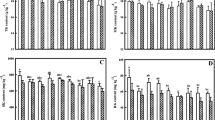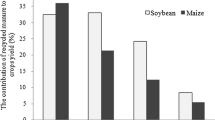Abstract
Influence of N, P and K application through inorganic and organic fertilizers on P and K removal in crop plants, changes in soil fertility status and their balance in the soil-plant (maize-wheat-cowpea fodder) studied for the first 22 years of a long-term experiment at Punjab Agricultural University farm, Ludhiana, India. The results showed that P uptake by wheat was about 1.5 times that of maize, whereas K uptake by wheat was only 1.1 times that of maize. The apparent P recovery by both maize and wheat depended on the rates of N, P and K application. Fertilizer rates greater than the recommended (150% NPK) resulted in lower P recoveries. At optimum level of N, P and K application (100% NPK) the mean P recovery (for 22 years) was 30.3% (±5.47) in wheat as compared to 20% (±11.35) in maize. The apparent P recovery in maize declined as the number of cropping years progressed. In 100% NPK plots, it declined from 45.6% in 1973 to 12.5% in 1992. The decline in P recovery was due to the accumulation of plant available P in the soil which increased from the initially low status to high-very high due to continuous application of P fertilizer. The application of FYM in conjunction with 100% NPK led to significantly greater accumulation of available P as compared to 100% NPK treatment alone despite the higher amount of total P removal in the former treatment than that from the latter. A trifle build-up in available K was observed in K amended plots notwithstanding the negative balance of K based on the approach of input-output relationship. The release of K from non-exchangeable form contributed towards K uptake by the crops. The results suggested the need for modifying the existing K fertilizer recommendations to compensate for gradual loss of native soil K fertility.
Similar content being viewed by others
References
Bailey LD, Spratt ED, Read DWL, Warder FG & Ferguson WS (1977) Residual effects of phosphorus fertilizer. II. For wheat and flax grown on chernozemic soils in Manitoba. Can J Soil Sci 57: 263–270
Bhardwaj V, Omanwar PK & Bansal SK (1982) Available potassium changes in a soil under continuous rotational cropping of rice, wheat and cowpea. J Indian Soc Soil Sci 30: 99–101
Biswas CR & Benbi DK (1989) Long term effects of manure and fertilizer on wheat-based cropping systems in semi arid alluvial soils. Fert News 34: 33–38
Biswas CR & Benbi DK (1996) Sustainable yield trends of irrigated maize and wheat in a long-term experiment on a loamy sand in semi-arid India. Fert Res: 46: 225–234.
Campbell CA, Read DWL, Winkelman GE & McAndrew DW (1984) First 12 years of long-term crop rotation study in south western Saskatchewan-Bicarbonate P distribution in soil and P uptake by the plant. Can J Soil Sci 64: 125–137
Cocharn WG & Cox GM (1957) Experimental Design. New York: John Wiley and Sons Inc.
Findley WI (1973) Influence of fertilizer use on the phosphorus and potassium status of sandy soils. Can J Soil Sci 53: 103–110
Gajri PR, Arora VK & Chaudhary MR (1994) Maize growth responses to deep tillage, straw mulching and farmyard manure in coarse textured soils of NW India. Soil Use Manage 10: 15–20
Gajri PR, Prihar SS & Arora VK (1989) Effect of nitrogen and early irrigation on root development and water use by wheat on two soils. Field Crops Res. 21:103–114
Ghosh AB & Biswas CR (1978) Potassium response and changes in soil potassium status with time. In: GS Sekhon (Ed) Potassium in soils and crops. pp 379–390, Potash Res Inst India, New Delhi
Lutz JA & Jones GD (1971) Crop yields and available P and K in soil as affected by sixteen annual applications of N, P and K fertilizers. J Indian Soc Soil Sci 19: 269–274
McCollum RE (1991) Buildup and decline in soil phosphorus: 30 year trends on a typic Umprabult. Agron J 83: 77–85
Olsen SR, Cole CV, Watanabe FS & Dean LA (1954) Estimation of available phosphorus in soil by extraction with sodium bicarbonate. US Dept Agric Circ, 939
Saroa GS, Biswas CR & Vig AC (1990) Phosphate utilization by maize under different residual P fertility. J Nuclear Agric Biol 19: 221–226
Schwab AP, Owensby CE & Kulyingyong S (1990) Changes in soil chemical properties due to 40 years of fertilization. Soil Sci 149: 35–43
Swarup A & Ghosh AB (1978) Effect of intensive fertilizer use based on soil tests on the available potassium status in soil and potassium content of crops. Indian J Agron 23: 289–294
Author information
Authors and Affiliations
Rights and permissions
About this article
Cite this article
Benbi, D., Biswas, C. Nutrient budgeting for phosphorus and potassium in a long-term fertilizer trial. Nutrient Cycling in Agroecosystems 54, 125–132 (1999). https://doi.org/10.1023/A:1009720103190
Issue Date:
DOI: https://doi.org/10.1023/A:1009720103190




